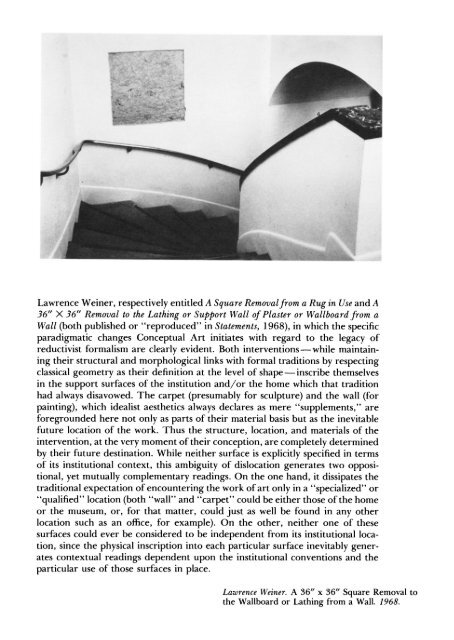Buchloh, conceptual art.pdf - Course Materials Repository
Buchloh, conceptual art.pdf - Course Materials Repository
Buchloh, conceptual art.pdf - Course Materials Repository
You also want an ePaper? Increase the reach of your titles
YUMPU automatically turns print PDFs into web optimized ePapers that Google loves.
:i~j::::-:ii::':::i-<br />
.......::<br />
jiiiiiiiiii<br />
...iiiiiiii~iii ._: ::? ::I -:i:<br />
-i:-!iI :i:: :-i-lijiiil-ilii-:i:i<br />
i1::::::?_:::?::::::::::<br />
:???::<br />
??:!i~~i<br />
::-:.-_:::::_i: ::-i:iii:i:_r: : ::i:::::::: ::: -: :: :<br />
iiiii-i-iii iil:<br />
jii:--; :iii-iii'_?<br />
Lawrence Weiner, respectively entitled A Square Removalfrom a Rug in Use and A<br />
36" X 36" Removal to the Lathing or Support Wall of Plaster or Wallboard from a<br />
Wall (both published or "reproduced" in Statements, 1968), in which the specific<br />
paradigmatic changes Conceptual Art initiates with regard to the legacy of<br />
reductivist formalism are clearly evident. Both interventions - while maintaining<br />
their structural and morphological links with formal traditions by respecting<br />
classical geometry as their definition at the level of shape--inscribe themselves<br />
in the support surfaces of the institution and/or the home which that tradition<br />
had always disavowed. The carpet (presumably for sculpture) and the wall (for<br />
painting), which idealist aesthetics always declares as mere "supplements," are<br />
foregrounded here not only as p<strong>art</strong>s of their material basis but as the inevitable<br />
future location of the work. Thus the structure, location, and materials of the<br />
intervention, at the very moment of their conception, are completely determined<br />
by their future destination. While neither surface is explicitly specified in terms<br />
of its institutional context, this ambiguity of dislocation generates two oppositional,<br />
yet mutually complementary readings. On the one hand, it dissipates the<br />
traditional expectation of encountering the work of <strong>art</strong> only in a "specialized" or<br />
"qualified" location (both "wall" and "carpet" could be either those of the home<br />
or the museum, or, for that matter, could just as well be found in any other<br />
location such as an office, for example). On the other, neither one of these<br />
surfaces could ever be considered to be independent from its institutional location,<br />
since the physical inscription into each p<strong>art</strong>icular surface inevitably generates<br />
contextual readings dependent upon the institutional conventions and the<br />
p<strong>art</strong>icular use of those surfaces in place.<br />
iii'<br />
Lawrence Weiner. A 36" x 36" Square Removal to<br />
the Wallboard or Lathing from a Wall. 1968.
















